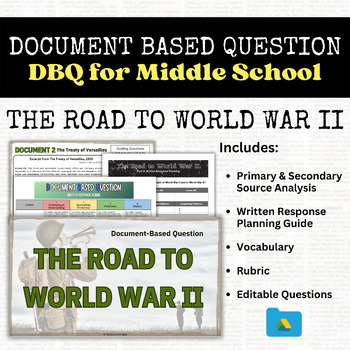DBQ for Middle School - The Road to World War II: Primary & Secondary Sources
Mastery in Middle
52 Followers
Grade Levels
6th - 10th
Resource Type
Standards
CCSSRI.6.1
CCSSRI.6.8
CCSSRI.7.1
CCSSRI.7.8
CCSSRI.8.1
Formats Included
- Google Drive™ folder
Mastery in Middle
52 Followers

Made for Google Drive™
This resource can be used by students on Google Drive or Google Classroom. To access this resource, you’ll need to allow TPT to add it to your Google Drive. See our FAQ and Privacy Policy for more information.
Description
This no-prep resource is your complete guide to integrating literacy and social studies through a Document Based Question analysis and written response.
This resource asks students to analyze primary and secondary sources in order to answer the essential question: How did the events and aftermath of World War I lead to World War II?
Included within this resource are:
1. Vocabulary
2. DBQ: 5 documents with editable guiding questions
3. A written response planning guide (editable)
4. Mastery-based rubric to assess content, writing, and formatting (editable)
You will receive a Google Folder, and all resources are either in a Google Doc or Google Slide format so that you can share them directly with your students.
Total Pages
Answer Key
N/A
Teaching Duration
N/A
Report this resource to TPT
Reported resources will be reviewed by our team. Report this resource to let us know if this resource violates TPT’s content guidelines.
Standards
to see state-specific standards (only available in the US).
CCSSRI.6.1
Cite textual evidence to support analysis of what the text says explicitly as well as inferences drawn from the text.
CCSSRI.6.8
Trace and evaluate the argument and specific claims in a text, distinguishing claims that are supported by reasons and evidence from claims that are not.
CCSSRI.7.1
Cite several pieces of textual evidence to support analysis of what the text says explicitly as well as inferences drawn from the text.
CCSSRI.7.8
Trace and evaluate the argument and specific claims in a text, assessing whether the reasoning is sound and the evidence is relevant and sufficient to support the claims.
CCSSRI.8.1
Cite the textual evidence that most strongly supports an analysis of what the text says explicitly as well as inferences drawn from the text.


